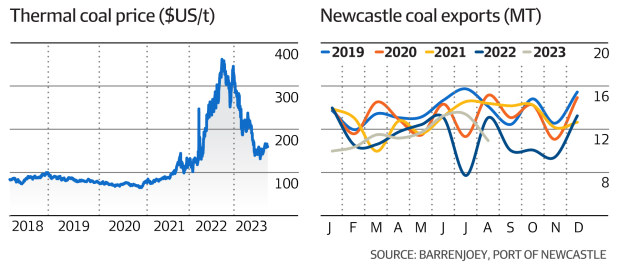Coal shipments have worst August for years, but value rose to more than $60
Top quality Newcastle thermal coal increased 11 per cent over August to US$159 per tonne, analysts at Barrenjoey Capital Partners estimate.
“[This] reflects perhaps the decline in supply and jump in European gas
price on the back of potential [LNG] supply restrictions in Western Australia from industrial unrest,” said Barrenjoey’s analyst Glyn Lawcock. Coal and gas power generation compete for market share, linking gas and coal prices.
Demand is expected to pick up from September as countries in the northern hemisphere stock up on coal ahead of winter, according to Andrew Jones, a coal analyst at Argus Media, an energy data provider.
Newcastle coal prices have risen above $US160 per tonne this week, after bottoming out at a 52-week low of $US131 per tonne in July, as demand increases and supply constraints curb east coast coal exports.

Water-damaged mines from deluges linked to La Nina throughout the year, labour shortages and transport delays are “keeping a lid on production”, said Rory Simington, an analyst at Wood Mackenzie. “The miners are really struggling to keep up in this tight market,” he said.
“Despite the fact that it’s been drier, there are many mines in the Hunter Valley that still have a lot of water at the sites. And they’re unable to just get rid of it because it’s polluted, so there are limits on how much they can put into the river and get rid of. Some miners are pumping water from one part of the mine to another so that they can mine.”
Still, the miners continue to face unseasonably high levels of rain. Cessnock, the closest town to the Hunter coalfields, experienced rainfall that was 20 per cent above the long-term median in August.
But Mr Simington said the labour shortage is the bigger issue. Whitehaven Coal and Yancoal have flagged this as a major barrier to production.
“We’ve been talking to some big producers and one of them had over 400 positions, that it was trying to fill. We also know of some smaller operators, single mine operators, that are short 100 people. That’s a big issue that everyone seems to be struggling with,” he said.
“We’ve been told by a big producer that last year they had equipment parked on every shift because they didn’t have the people to operate it.”
And higher Newcastle coal prices have spurred Japanese buyers to seek out cheaper, lower quality alternatives amid a broader drop off in overall coal imports, said Argus Media’s Mr Jones. “Japan is a big buyer of Australian coal, but Japanese utilities have the ability to switch quite easily between natural gas and coal depending on prices. One of the things that we saw in August was a steep drop-off in Japanese coal imports, overall, not just from Australia.”
Still, demand from China – the world’s largest importer – rebounded in August close to the levels reached before Beijing banned Australian coal in late 2020. Australia’s exports of thermal and coking coal – used in steel making – came in at 6.69 million tonnes in August, based on Chinese customs data. The ban was lifted earlier this year.
Read More: Coal shipments have worst August for years, but value rose to more than $60

